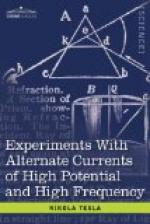At Cartstatt he was so diligent as to compress the
four years’ course into three, and graduated
in 1873. Returning home during an epidemic of
cholera, he was stricken down by the disease and suffered
so seriously from the consequences that his studies
were interrupted for fully two years. But the
time was not wasted, for he had become passionately
fond of experimenting, and as much as his means and
leisure permitted devoted his energies to electrical
study and investigation. Up to this period it
had been his father’s intention to make a priest
of him, and the idea hung over the young physicist
like a very sword of Damocles. Finally he prevailed
upon his worthy but reluctant sire to send him to
Gratz in Austria to finish his studies at the Polytechnic
School, and to prepare for work as professor of mathematics
and physics. At Gratz he saw and operated a Gramme
machine for the first time, and was so struck with
the objections to the use of commutators and brushes
that he made up his mind there and then to remedy
that defect in dynamo-electric machines. In the
second year of his course he abandoned the intention
of becoming a teacher and took up the engineering
curriculum. After three years of absence he returned
home, sadly, to see his father die; but, having resolved
to settle down in Austria, and recognizing the value
of linguistic acquirements, he went to Prague and
then to Buda-Pesth with the view of mastering the
languages he deemed necessary. Up to this time
he had never realized the enormous sacrifices that
his parents had made in promoting his education, but
he now began to feel the pinch and to grow unfamiliar
with the image of Francis Joseph I. There was considerable
lag between his dispatches and the corresponding remittance
from home; and when the mathematical expression for
the value of the lag assumed the shape of an eight
laid flat on its back, Mr. Tesla became a very fair
example of high thinking and plain living, but he
made up his mind to the struggle and determined to
go through depending solely on his own resources.
Not desiring the fame of a faster, he cast about for
a livelihood, and through the help of friends he secured
a berth as assistant in the engineering department
of the government telegraphs. The salary was five
dollars a week. This brought him into direct
contact with practical electrical work and ideas,
but it is needless to say that his means did not admit
of much experimenting. By the time he had extracted
several hundred thousand square and cube roots for
the public benefit, the limitations, financial and
otherwise, of the position had become painfully apparent,
and he concluded that the best thing to do was to make
a valuable invention. He proceeded at once to
make inventions, but their value was visible only
to the eye of faith, and they brought no grist to
the mill. Just at this time the telephone made
its appearance in Hungary, and the success of that
great invention determined his career, hopeless as




